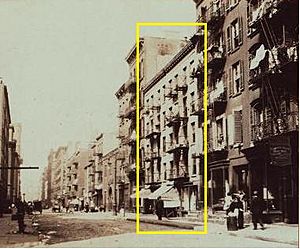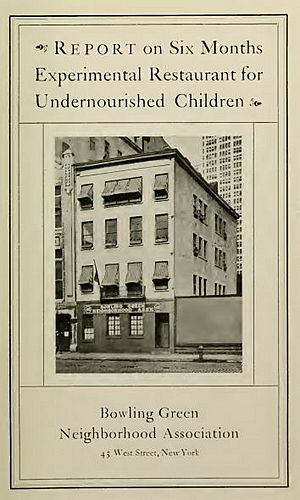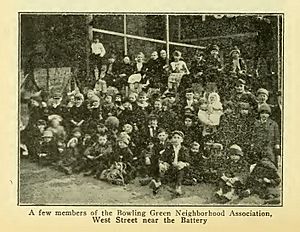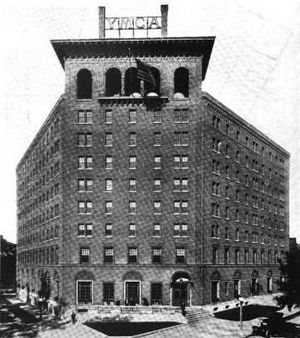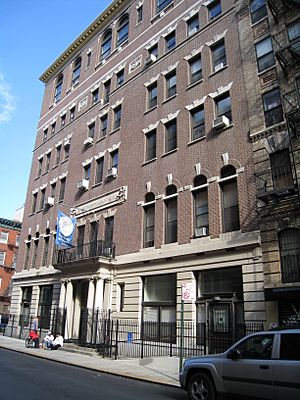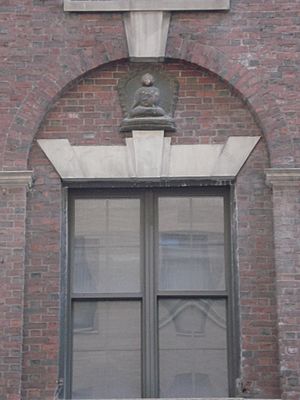Downtown Community House facts for kids
The Downtown Community House at 105-107 Washington Street is a six-story, red brick building. It's one of the last remaining signs of a historic immigrant neighborhood in Lower Manhattan called “Little Syria.”
Starting in 1926, the Bowling Green Neighborhood Association used this building as a settlement house. This meant it was a place that offered help and services to immigrant families in the area. The building was constructed in 1925. It was funded by William H. Childs, who founded the Bon Ami cleaning product company. The architect, John F. Jackson, designed many Y.M.C.A. buildings. The building's Colonial Revival style showed a wish for immigrants in the neighborhood to feel more American and connect with the country's history. Recently, groups working to save historic buildings and Arab-American activists have asked the Landmarks Preservation Commission to make the building a city landmark.
Contents
Early Days of the Building
The Downtown Community House was finished in 1926. Before that, the land had two older residential buildings. These buildings were likely built before 1822. By the 1860s, these buildings were boarding houses for Irish immigrants and sailors. One building even had a saloon.
The area was known for being rough due to its closeness to the docks. In 1894, an inspection found the buildings dirty and poorly ventilated. By 1896, health officials said the buildings were unsafe. They were fixed up in 1897 and people moved back in. This included new Syrian immigrants. In 1920, a company bought the buildings. Then, in 1925, the land was bought to build the Downtown Community House.
Helping the Community
The Bowling Green Neighborhood Association started in 1915. It first focused on helping children. Over time, it grew to offer services for adults too. These services included education and health. The Association had a medical and dental clinic. They also held folk dances, holiday fundraisers, and English classes. Their goal was to "weld together the peoples of the many nations" in the Bowling Green area.
In 1922, the Association noted that the neighborhood had high rates of infant deaths and tuberculosis. They described the area as a first home for many immigrants. These included people from Italy, Greece, Turkey, Armenia, Syria, and Poland. In the late 1910s and early 1920s, this Association was one of the only health clinics in downtown Manhattan.
The Association published yearly reports about their work. They reported a big drop in infant deaths between 1910 and 1924. They also saw a decrease in the overall death rate. About 400 people attended their playground daily. Their Health Center had four doctors and a part-time dentist. They did important studies on children's nutrition. They helped thousands of patients. In 1919, they had many doctor and nurse visits. Infant deaths were cut almost in half.
In 1917, the Police Commissioner, Arthur Woods, praised the Association. He said they had created a successful plan for community help. In 1918, they did a study where they gave immigrant children three meals a day for six months. This taught parents about good nutrition. These achievements were well-known in New York. They were often written about in newspapers and health journals.
The Association also cared a lot about clean living conditions. Workers at the Downtown Community House looked for dirty or unsafe homes. They would report these to a social worker. The social worker would then tell the building owner or agency. If improvements weren't made, they would contact the government. This led to a full housing survey and big improvements in the neighborhood. Some buildings were even torn down or completely rebuilt.
William H. Childs' Gift
In 1925, William H. Childs gave $250,000 to the Bowling Green Neighborhood Association. Childs was the founder of the Bon Ami cleaning company. Other wealthy people from nearby Wall Street also promised to double their yearly donations.
William Hamlin Childs (1857-1928) became rich from the soap and detergent business. His father's mill had leased space to a scientist. This scientist created a gentle cleaning agent called Bon Ami. It was made from ground feldspar and liquid soap. Childs and his cousin became the main sellers of Bon Ami. By the 1890s, it was sold in paper packages with a yellow chick logo. By World War I, Bon Ami powder was sold worldwide. It even did well during the Great Depression.
Childs' success made him very wealthy. He used his money and time for good causes. He helped the Beekman Street Hospital and other charities. His reputation helped him get more pledges from Wall Street investors. With these promises, the Association could help more people. They expanded their services to an estimated 10,000 people. These people spoke twenty-five different languages. In March 1925, they bought a new, larger space at 105-107 Washington Street.
The New Community House Opens
The new Downtown Community House opened on May 5, 1926. It was designed by architect John F. Jackson. The opening included plays by local children and a speech by Mayor Jimmy Walker. The event showed a strong sense of American pride. Mayor Walker said the Community House was "making the Stars and Stripes brighter than ever."
The building had the first public library in Downtown Manhattan. It started with 1,000 books. It also had clinics, a milk dispensary, a hall, a cooking school, and a gym. There was even a special nursery for babies. In its first year, workers made over 10,570 visits. These visits included medical help, checking on local homes, and helping people get work papers.
In the years after it opened, the Downtown Community House offered many activities. These included musicals, a drama club, and classes on running a home. They also held Christmas events for children. Wealthy sponsors and companies donated food baskets and gifts. In 1929, the Association studied women's jobs in the area. They found that most women worked long hours cleaning offices at night. The survey led to free summer camps for these working women.
The medical center remained very important. It provided dental care to many schoolchildren. In one month in 1930, the health center had 3,774 visits. During the Great Depression, the Community House helped unemployed men. They directed plays, giving the men "something to work on."
In 1930, Guy Emerson became the Association's new president. However, surveys showed that many skyscrapers were being built. This caused the area's population to shrink. In 1940, the Bowling Green Neighborhood Association joined with the Beekman Street Hospital. Today, this hospital is known as New York Downtown Hospital. In 1945, the hospital sold the building.
Even after being sold, 105-107 Washington Street continued to help the neighborhood. In 1936, it became a center for adults with physical disabilities. It was the first center in the U.S. for recreation and sports for handicapped adults. It offered classes in arts, crafts, swimming, dancing, and sports. In 1943, the building became a government office for merchant sailors. In the 1950s, it was the headquarters for a longshoremen union. More recently, it housed the True Buddha Diamond Temple. Today, the building is empty.
Architect John F. Jackson
The Downtown Community House cost $300,000 to build. It was designed by John F. Jackson (1867-1948). Jackson was an architect who designed over 70 Y.M.C.A. buildings and community centers. He was born in New Brunswick, Canada in 1867. He later moved to New York City.
Jackson designed many Y.M.C.A. buildings in New York. These included the Prospect Park Branch (1925) and the Harlem 135th Street Branch (1918). He also designed other community centers. His work extended beyond New York City. He designed Y.M.C.A.s in Rochester, New York, and in Canadian cities like Montreal and Ottawa. His designs were often featured in architectural magazines.
Jackson's style often mixed Colonial Revival and Italian Renaissance details. He often used red brick and limestone.
Colonial Revival Style
The Colonial Revival was a popular architectural style in the United States. It was used from the late 1800s to the 1930s. This style tried to copy the look of early American buildings. It became popular after the 1876 Centennial celebration. This event brought a new sense of patriotism.
The style was common for homes. It took ideas from Georgian and Neoclassical buildings. Key features included symmetrical brick fronts, fancy front doors, and Palladian windows. It also often had gabled or mansard roofs and classical details.
Patriotism was a big reason for this style's popularity. Around 1900, many immigrants came to the U.S. People wanted to show and define American identity. After World War I, the country needed comfort. The Colonial Revival style offered this by looking back to the past. It was meant to feel welcoming.
While often used for homes, Colonial Revival also became popular for public buildings. This included centers that served the poor, needy, or new immigrants. The style was chosen for community centers for several reasons. It offered many ways to decorate. More importantly, it helped show national pride to newcomers.
In the early 1900s, many community centers aimed to help immigrants become part of American society. Architecture played a role in this. Classes taught local history using pictures of old New York. Tours were given to immigrant children of historic landmarks. The idea was to teach newcomers about American history and values. The Colonial Revival style helped do this visually. It used shapes and materials from early America. This helped define America and teach patriotism. The style was a physical way to show the process of becoming American.
Many community houses in New York City used the Colonial Revival style. Examples include the University Settlement House (1901) and Greenwich House (1917). The University Settlement House is a six-story, red brick building. It has a grand entrance with columns. The Greenwich House is a seven-story, red brick building with a steep gabled roof. Other community houses across the country also used this style.
Building Design
The Downtown Community House is a six-story, red brick building. It has a granite base and a limestone first floor. The windows have limestone lintels with projecting keystones. There are stone plaques between each floor. The second-floor windows have arched surrounds. The roof is a slate mansard roof with metal-framed dormer windows.
Details like eagle and swag plaques above the third story windows show the building's connection to early American history. The windows get smaller and less decorated on each higher floor. This follows architect Jackson's idea of "good proportions" for community buildings. The eagle reliefs especially show the patriotism of the Colonial Revival style.
The original windows were three-over-three double-hung windows. The main entrance has two fluted pilasters and a decorative arch. On either side are service entrances with original windows. The mansard roof is special for Jackson's buildings. It was likely chosen to give good ceiling heights on the top floor. It also helped the building stand out from its neighbors.
The mansard roof might have been inspired by Colonial Revival clubhouses in New York City. Jackson suggested that community houses should have a "club-like appearance." This meant they should look fancy, like buildings used by wealthy people. This look suggested a rich lifestyle with roots in early America. Examples like the "Old" Colony Club (1905-1906) with its gray slate roof might have influenced Jackson's design.
The building has had only small changes over time. It was changed to office space in 1946. Then it became a community house again in 1949. The windows were replaced in 1965. When it became a Buddhist temple in 2003, small Buddha ornaments were added above the second-story windows. The entrance pilasters and the base have also been painted. A Chinese-style terra-cotta cornice was added above the ground floor, but it is now in disrepair.


